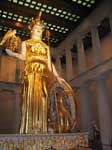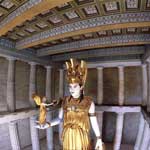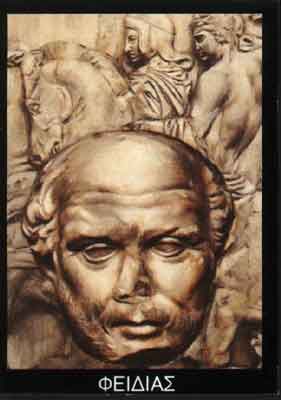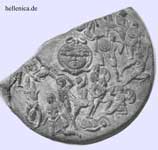.
Die kolossale Statue der Athena Parthenos
|
Now Zeus, king of the gods, made Metis (wisdom) his wife first, and she was wisest among gods and mortal men. But when she was about to bring forth the goddess bright-eyed Athene, Zeus craftily deceived her with cunning words and put her in his own belly, as Earth and starry Heaven advised. For they advised him so, to the end that no other should hold royal sway over the eternal gods in place of Zeus; for very wise children were destined to be born of her, first the maiden bright-eyed Tritogeneia, equal to her father in strength and in wise understanding; but afterwards she was to bear a son of overbearing spirit, king of gods and men. But Zeus put her into his own belly first, that the goddess might devise for him both good and evil. *Tritogeneia : probably Athena, who was born on the banks of the river Trito. Zeus instructed Hephaistos to open up his skull with an axe. Athena emerged from his head fully arrmed. Why is Athena called Athena? My favorite interpretation from Cratylus, Athena is from “theonoa” (θεονόα ή θεονόη) born from God's (Zeus) mind. |
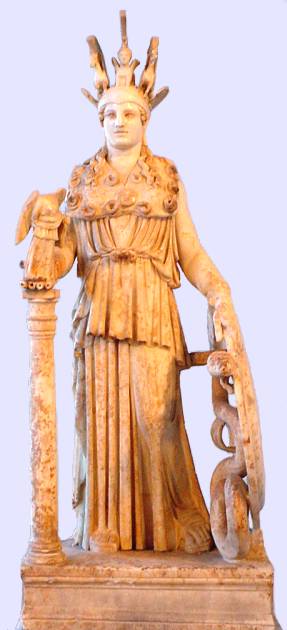
A small copy of the colossal Athena Parthenos (“Maiden” but also “Virgin”) Statue of Pheidias in the Parthenon, Athens. A High Classical sculpture from the Sculptor Pheidias. This version is the so-called Athena Varvakeion (around 1 m large) from a the place it was found, near a Varvakeion school in 1880 from the 2nd century AD (around 500 later than the Parthenos
sculpture of Pheidias), now in the National Museum in Athens, Greece. The original 12 m large Athena Parthenos was produced by Pheidias in approximately 9 years work. Another large bronze sculpture (the total height of the statue was 9m according to Stevens and Raubitschek or 16.30m according to Dinsmoor ) was also produced by Pheidias, the so called Athena Promachos and also the so-called Athena Lemnia is a work of Pheidias. More than 1000 kg gold was used for the gold ivory statue, the costs estimated between 700 and 1000 talents. Together with the gold-ivory statue of Zeus, also from Pheidias, one of the few known giant Greek sculptures covered with gold. Another sculpture produced 100 years earlier and covered with gold was the probably 8 m large Apollo of Delos, a work of Tektaios and Angelion.
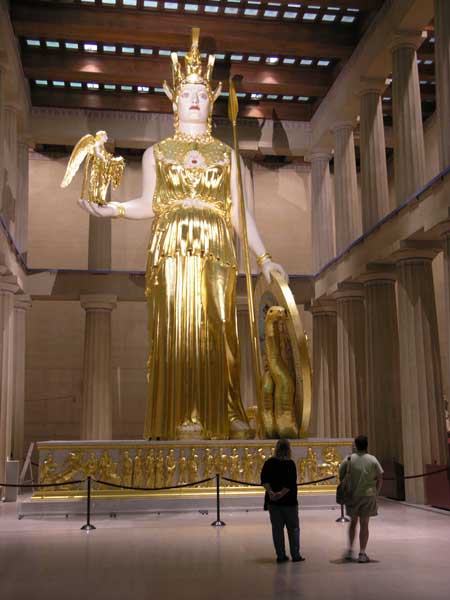
Athena Parthenos a modern reconstruction (Image from Stoa )
The Cella of the Ancient Parthenon with the Statue of Athena (Back View) and (Front View)
The colossal statue of the Athena Parthenos by Pheidias was completed in 438 BC. The original work was made of gold and ivory (chryselefantine) and stood some 12 m high. The goddess stood erect, wearing a tunic, aegis, and helmet and holding a goddess of victory, a Nike, in her extended right hand and a spear in her left. The snake represents Erichtonios, a legendary king. On the statue base the creation of Pandora was shown. One of the most famous sculptures of antiquity survived a half millennium until it was destroyed. At about 295 BC Lachares, a local tyrant, removed the 3/4 mm thick gold plating from the wooden cores of the garments of the Athena Parthenos. Later a thin layer of gold leaf was applied again to regain the impression of the original. Around 250 BC and the last years BC also a major damage occurred to the Parthenon's interior (fire). The sanctuary was rebuilt. Finally the sanctuary was emptied and the temple was remodeled for the use of religions of those who later occupied the territory.
The statue itself is made of ivory and gold. In the middle of her helmet is placed an image of the Sphinx . . . and on either side of it are griffins in relief. . . . The statue of Athena stands upright, dressed in a full-length chiton, and on her breast a head of Medusa is represented in ivory. She carries a statue of Nike about 4 cubits [6 feet] high, and a spear in the other hand; a shield is placed by her feet, and near the shield is a serpent. This serpent would be Erichtonios. On the base of the image is represented the Birth of Pandora in relief. Pausanias Description of Greece, Book I, Attica
That Pheidias is extremely famous among all peoples who appreciate the reputation of his Zeus at Olympia, nobody doubts, but in order that those who have not seen his works may know that he is justly praised, I will offer some small points of evidence to prove who great his inventiveness was. To do this, I shall neither use as proof the beauty of the Zeus at Olympia, nor the size of the Athena which he made at Athens (since she is 26 cubits hight and is make of ivory and gold), but rather I shall use the battle of the Amazons which is carved in a circular pattern on the convex side of her shield; likewise on the concave side of it he represented the struggle of the gods and giants, and on her sandals that of the Lapiths and Centaurs, so fully did every part offer the opportunity for the application of his art. On the base is carved the scene which they call “the birth of Pandora,” with twenty gods present at the birth. The Victory is especially marvellous but experts admire the serpent and also the bronze sphinx which is placed below the point of her spear. Pliny the Elder, Natural History,
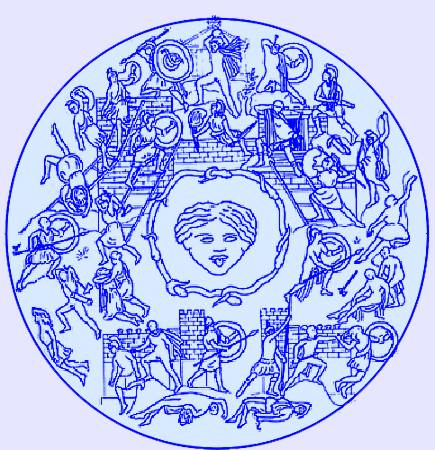
The Shield of Athena Parthenos, battle of the Athenians against the Amazons ,the women warriors, (Amazonomachy). Some opponents of Pheidias said that 2 figures of the Shield are the images of Pheidias and his friend Pericles. See: http://www.goddess-athena.org/Museum/Sculptures/Alone/Shield_reconstruction_x.htm
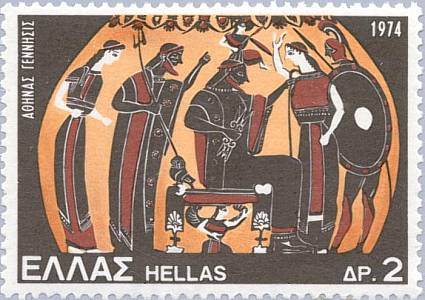
Athena's birth from Zeus head (Germans have a special word “Kopfgeburt”, a head birth, probably derived from this mythological story ). Image from Black figured vase, 6th century BC, Musee du Louvre, Paris
The Birth of Athenaon Black-figured Vases
Pindar, speaking of the island of Rhodes, says that Zeus “rained down on the city with golden flakes of snow” at the time Athene was born from Zeus’ head, “shouting with a far-ringing cry, and all Heaven and Mother Earth shuddered before her.” Jupiter, Gold, and the Birth of Athene
For instance, it was a saying of Xenophanes that to assert that the gods had birth is as impious as to say that they die; the consequence of both statements is that there is a time when the gods do not exist. Aristotle, Rhetoric, Book II
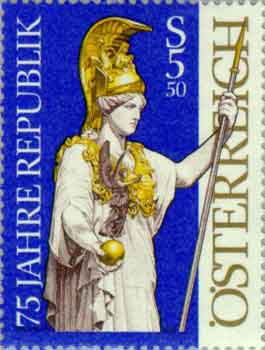
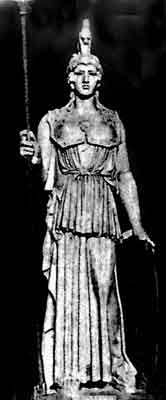
Athena Parthenos version in Madrid, Museo del Prado
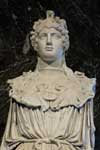
... it is said that Pheidias entered a contest to make a statue of Athena (Overbeck, No. 772). Two statues were to be made. Both were to be set on high columns. Alkamenes made one, Pheidias the other. Pheidias made his Athena as would one who knew optics and geometry and “knowing that things that are high will appear very small.” His Athena was made with her mouth open, nostrils distended, and the rest in proportion to the height of the columns. As a result, the sculptor was in danger of being stoned by the outraged populace. But when both statues were raised on their columns, Pheidias was seen to have produced a statue admirable for the excellence of its sculptural technique, whereas Alkamenes, whose statue had earlier been admired, was subjected to ridicule. Creativity in Art
Athena Promachos (Champion)
...a bronze image of Athena, a tithe taken from the Persians who landed at Marathon, a work of Pheidias; they say, however, that the battle of Laipths and Centaurs on her shield, as well as the other scenes wrought upon it, were engraved by Mys, and that these and the rest of the works of Mys were drawn for him by Parrhasios the son of Euenor. The point of the spear of this Athena and the crest of the helmet become visible to approaching sailors as soon as they round Cape Sounion Pausanias
Pheidias also build the gigantic bronze statue of Athena Promachos ( fight in the first line), built between 450 BC and 448 BC (construction time around 9 years ?). The base was 1.50 meters high, while the total height of the statue was 9m according to Stevens and Raubitschek or 16.30m [50 Doric feet] according to Dinsmoor. In 525 AD Athena Promachos was transported to Contantinople (Instabul), the center of the East Roman Empire. Athena Promachos was destroyed there by Christian fanatics in the 13-th century.
Another Statue by Pheidias at Plataea, Athena Areia , was said to be not much smaller than the Promachos (Paus.9.4.1).
| Ancient Greece
Science, Technology , Medicine , Warfare, , Biographies , Life , Cities/Places/Maps , Arts , Literature , Philosophy ,Olympics, Mythology , History , Images Medieval Greece / Byzantine Empire Science, Technology, Arts, , Warfare , Literature, Biographies, Icons, History Modern Greece Cities, Islands, Regions, Fauna/Flora ,Biographies , History , Warfare, Science/Technology, Literature, Music , Arts , Film/Actors , Sport , Fashion --- |

